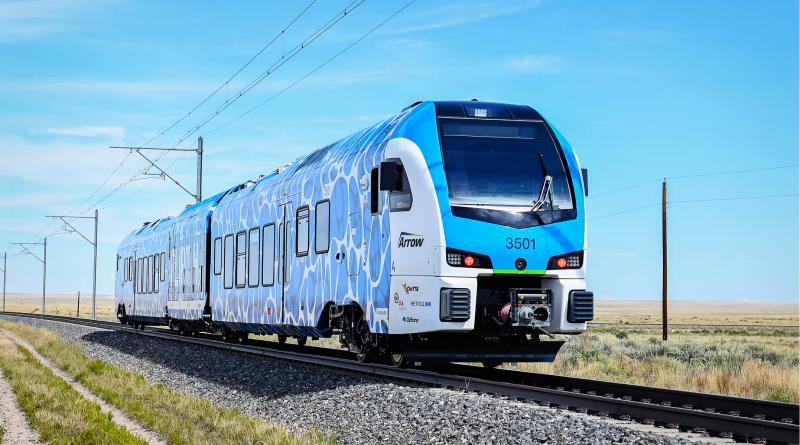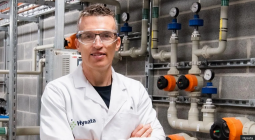‘Transformational’: how a California city launched America’s first hydrogen-powered passenger train

California's new Zero-Emissions Multiple Unit, known as Zemu, uses a hybrid hydrogen fuel cell and battery system/Photograph: Courtesy of Stadler Inc
There’s a new train pulling into the station in San Bernardino, a southern California city about 60 miles from Los Angeles. From the outside, it looks like any other commuter train, with three passenger carriages, blocky windows and a colourful blue exterior.
But inside, it’s unlike anything the region – or the country – has seen before. The $20m Zero-Emission Multiple Unit, known as Zemu, uses a hybrid hydrogen fuel cell and battery system to propel the train and run other onboard electrical systems. The only byproduct of the fuel cell is water vapour, a welcome change in an area known as the Inland Empire that suffers from some of the worst air quality rates in the country.
The new technology will make Zemu the first hydrogen-powered, zero-emissions passenger train in North America to meet Federal Railroad Administration (FRA) requirements when it goes into service early next year.
The train will run between the cities of Redlands and San Bernardino on a 9-mile line known as the Arrow Corridor; it’s one of the region’s smallest, carrying an estimated 416 daily weekday and 6,433 weekend riders, but ridership is growing. Its operators hope that Zemu, which was unveiled to the media last week, paves the way for clean energy trains to run on hundreds of miles of track in southern California and across the country.
It could mark the start of a clean energy rail movement in the US, which has traditionally lagged behind places like Europe when it comes to both train ridership and innovation. It’s also a win for California, which has struggled to get ambitious rail projects like its high-speed bullet train between San Francisco and Los Angeles off the ground.
“What we have done with Zemu is transformational,” said the president of the San Bernardino county transit authority (SBCTA), Ray Marquez, in a statement. “The development of the train has solidified SBCTA’s place as an innovator in clean passenger rail here in the Inland Empire, throughout the state and the nation.”
A project years in the making
The debut of this technology in North America comes as the greater Los Angeles region prepares for the 2028 Olympics, which the city’s mayor has said will be a “no-car” games, and as California ramps up its efforts to meet 2045 carbon neutrality goals.
San Bernardino has long suffered from poor air quality brought on by a high concentration of freeways, rail yards and industrial facilities including shipping warehouses. The city failed the American Lung Association’s 2024 State of the Air index, which is based on the number of days that ozone and particle pollution exceeded safe levels.
The project has been years in the making. A decade ago, motivated by the poor air quality and a desire to reduce the stress on the county’s roads, often crowded by trucks transporting goods from the nearby ports of LA and Long Beach, SBCTA officials set out to find clean alternatives to their existing diesel trains.
They landed on the hydrogen fuel-powered Zemu, and in 2019 contracted with Swiss rail manufacturer Stadler Inc to deliver on that mission, said Tim Watkins, chief of legislative and public affairs at the transit authority.
A fleet of hydrogen-powered trains, built by the French manufacturer Alstom, have been operating in Germany and Austria since 2018, but similar trains have never run in North America.
Hydrogen fuel cells combine hydrogen and oxygen molecules to generate electricity and produce water vapour as a byproduct. In practice, the fuel cell functions as an onboard generator that charges the batteries that turn the wheels of the train, driving it forward as well as running electrical systems. Inside the cell, hydrogen molecules, composed of one negatively charged electron and one positively charged proton, are split apart. The protons pass through a membrane, leaving the electrons behind. In order to rejoin the protons, the electrons jump the membrane, generating electricity in the process.
Though the onboard process does not directly emit greenhouse gases, the production processes to create hydrogen fuel in the US almost always do.
For riders, the application of this technology means a quieter ride. “All you’re going to hear is a couple HVAC blowers and cooling fans,” said Kaden Killpack, a commercial project manager at Stadler US who oversees the SBCTA and Caltrans projects. Riders might also notice a smoother journey due to the train’s lightweight construction.
However, the lightweight, aluminium-body design posed new challenges for Stadler, which needed to prove its trains could operate safely on California’s existing rail infrastructure. Lighter trains are more energy efficient, but in order to operate on the same tracks as heavy freight, Stadler needed to demonstrate that its aluminium trains could pass the FRAs high standards for front-end collisions, which it did with diesel-powered units in 2018.
Developing a lightweight frame that passed FRA standards is a promising accomplishment because it provides a zero-emission alternative to the expensive overhead electrification that’s common in Europe, but is a prohibitively expensive retrofit on freight lines in the US. “Once you take that vehicle and you add hydrogen to it, you make it possible to have zero emission technology on the same corridors where Union Pacific and NSF run,” Killpack said. “That’s what’s really crazy and cool about this”.
The start of something bigger?
Placing the Zemu on the Arrow Corridor is admittedly a small first step, Watkins says: “It’s one train, so it doesn’t move the needle dramatically.” But, he says, “it introduces the technology as a proof of concept” that could run on more than 500 miles of southern California’s regional rail system and beyond.
It’s a concept that California leaders have already acted on. After seeing the early success of the Zemu project last year, the state’s department of transportation – known as Caltrans – commissioned Stadler to build longer versions of the hydrogen-powered trains that will run between Merced and Sacramento in the Central Valley on a yet-to-be-built line. So far, Caltrans has ordered 10 units, with the option to buy 19 more under the terms of the $80m contract. The first units could arrive as soon as 2027.
In order for these small but promising steps to be economically sustainable in the long run, though, huge investment will need to be made to expand the infrastructure. “You’ve got to be selling at least hundreds [of trains] to start to get some scale economies and bring those costs down,” said Lewis Fulton, the Energy Futures Program director at UC Davis’s Institute for Transportation Studies.
Some, meanwhile, point out that a pivot to hydrogen power comes with its own flaws. Because hydrogen is so light, a large volume of gas is needed to produce a train-fleet-fueling amount of electricity, making it not an especially energy dense fuel, says Paul Erickson, a hydrogen fuel expert and the director of the Energy Research Laboratory at UC Davis. Hydrogen must also undergo several transformations between its natural state and its use for electricity, further reducing its efficiency, he explains.
And extracting hydrogen from nature, where it’s bonded to other elements, itself requires energy; unless that power comes from renewable sources like wind and solar, some carbon is therefore released into the atmosphere in the production process. Erickson says he thinks it would be more effective to invest in renewable diesel fuels for transportation instead of building new infrastructure from the ground up.
But regardless of the challenges, California officials are forging ahead. Through a combination of state, federal and private funding, California’s Alliance for Renewable Clean Hydrogen Energy Systems (Arches) will distribute some $12.6bn to get thousands of hydrogen-powered buses, trucks and cars onto the road and to build hydrogen manufacturing and distribution hubs to run these growing fleets.
Fulton, who also chairs the transportation working group at Arches, says the Zemu projects are a knock-on effect of this investment. “What we’re seeing in California now is a sense that hydrogen is coming and infrastructure is coming, and so why not tap into that?”





